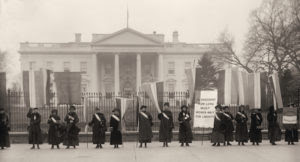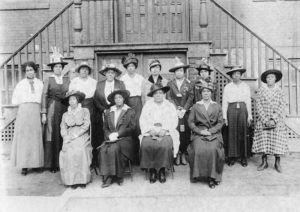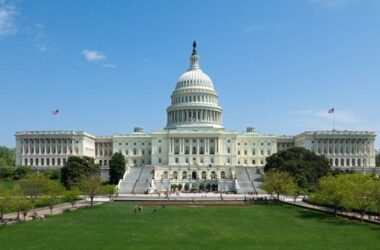CHARELSTON, W.Va. — “Women weren’t given the right to vote. They took it.“
This year marks the 100th anniversary of the ratification of the 19th Amendment which gave women in this country the right to vote.
WVPA NOTE: The global pandemic has put a damper on many of the planned celebrations and exhibitions — including plans for many of West Virginia’s celebrations during this year of the ratification of the 19th Amendment. The year-long series of celebrations in West Virginia are being coordinated by the West Virginia Secretary of State’s office. As part of the recognition, Secretary of State Mac Warner noted this week’s broadcast of “The Vote” on the American Experience on PBS. Warner shared this article from the weekly newsletter of Electionline.org, which is a nonpartisan, non-advocacy clearinghouse for election reform news and information.

Suffragists picket in front of the White House, Washington, DC, February 1917. Library of Congress.
From 9 p.m. until 11 p.m. today, Monday July 6, and Tuesday July 7, The American Experience on PBS presents The Vote, a four-hour, two-part documentary series, that tells the dramatic story of the epic crusade waged by American women for the right to vote. Focusing primarily on the movement’s final decade, the film charts American women’s determined march to the ballot box, and illuminates the myriad social, political and cultural obstacles that stood in their path.
The Vote delves into the controversies that divided the nation in the early 20th century –– gender, race, state’s rights, and political power — and reveals the fractious dynamics of social change.
“The hard-fought campaign waged by American women for the right to vote was a truly transformative cultural and political movement, resulting in the largest expansion of voting rights in American history,” said executive producer Susan Bellows. “It’s also a story that has usually been reduced to a single page in the history books. The Vote restores this complex story to its rightful place in our history, providing a rich and clear-eyed look at a movement that resonates as much now as ever.”

Phyllis Wheatley Club, Buffalo, NY, was an affiliate of the National Association of Colored Women’s Clubs. Founded in 1899, they established a settlement house in 1905. They developed programs to feed the hungry, donated books by Black authors to school libraries, established kindergartens, and organized mother’s clubs to teach parenting skills. Credit: Library of Congress, Nannie Helen Burroughs Collection.
Although rightly regarded as a milestone for both American women and American democracy, the 19th Amendment was not quite the simple turning point it is generally perceived to be. Millions of women voted before the amendment and millions more were prohibited from voting after it, particularly African American women in the South. Nor was the ballot a favor bestowed upon women by an enlightened, progressive society. The right to vote was, in fact, fought for and won –– by three generations of American women who, over the course of more than seven decades, not only carried out one of the most sustained and successful political movements in all of American history, but were also the first to employ the techniques of nonviolent civil disobedience that later would become the hallmark of American political protest.
From the moment the clamor for woman suffrage first was raised in the United States, in the 1840s, the question was how the vote would ever be won. Resistance to women’s participation in the political sphere came from every quarter of American society –– from political machines eager to maintain their power, industrial interests fearful for their profits, even many women, who were convinced that wielding the ballot would somehow diminish their influence in society. Compounding the opposition, from the late 19th century on, was the poisonous legacy of Reconstruction and the determination of the former Confederate states to preserve white supremacy, in large part by barring African Americans from the polls.
As of 1909, despite six decades of relentless struggle, suffragists could point to little in the way of progress. Just four states had extended the franchise to women; the federal woman suffrage amendment –– introduced in the Senate in 1878 –– had virtually no support on Capitol Hill; and most in the first generation of activists had gone to their graves without casting a ballot. What had begun as a crusade of the few, however, had become a mass movement –– and their collective impatience was mounting.

The Great Demand, unveiled at the Suffrage Parade in Washington, DC, March 1913. National Archives.
As suffragists attempted to navigate the treacherous shoals of the national political scene, time and again principle was sacrificed in the name of pragmatism. Unfolding after the Civil War, when racism was both “a political fact and a political strategy,” said historian Martha Jones, the crusade for woman’s suffrage mirrored its historical moment. When expedient, white suffragists proved willing to accommodate its pervasive and deeply pernicious politics of exclusion. The Vote engages this troubled history directly –– underscoring the contributions of women of color to the struggle, the challenges of coalition-building in a fundamentally unequal society, and most importantly, the significant limitations of the 19th Amendment.
“The lengths to which women had to go in their pursuit of the ballot will likely come as a surprise to most viewers,” said writer, director and producer Michelle Ferrari. “How many people are aware that suffragists were the first Americans to picket the White House? That those women were jailed, went on hunger strikes and were force-fed by authorities? And that the techniques of non-violent civil disobedience, which we usually associate with the Civil Rights Movement, were employed first by women fighting for the right to vote?”

Ida B. Wells wearing a button she created to publicize a memorial service for African-American combatants court-martialed and hanged in Houston, Texas, in the summer of 1917. The button reads “In Memoriam Martyred Negro Soldiers Dec. 11, 1917.”Credit: University of Chicago.
In addition to the two-night movie, on the American Experience’s web site you can find digital shorts on Ida B. Wells, Alice Paul, Harriot Stanton Blatch, and Carrie Chapman Catt. There are also articles about the first woman to vote in Utah and Black women’s 200 year-fight for the vote.
The site also features an interactive called She Resisted: Strategies for Suffrage. She Resisted explores the final decade of the women’s suffrage movement through its most powerful images, brought to life with color for the first time. Live through the epic 1913 Washington, D.C. procession, in which thousands of women took to the streets to demand their right to the franchise; thrill at Ida B. Wells’s successful voter registration drive; and admire suffragists’ commitment to nonviolent resistance, which included hunger strikes and withstanding brutal force feedings. Working with renowned photographic colorist Marina Amaral to meticulously restore color to century-old archival stills, and video enhancement experts neural.love to upscale and colorize archival footage using neural networks, American Experience brings you an intimate look at the women who forever transformed the politics of social and political change in America.





